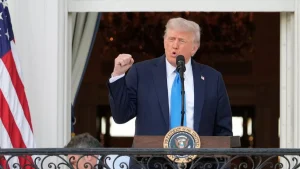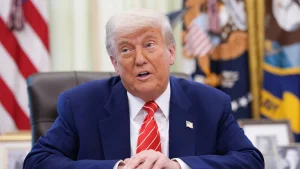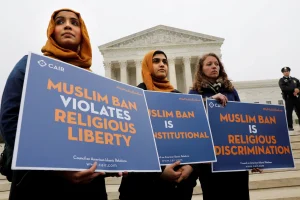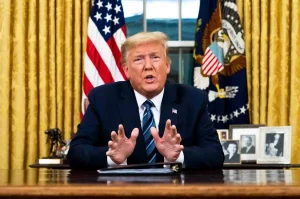Washington D.C. – President Donald Trump has implemented a comprehensive Trump travel ban that significantly expands immigration restrictions, affecting nationals from 19 countries worldwide. The 78-year-old president issued this sweeping proclamation on Wednesday, marking a dramatic escalation in his administration’s immigration enforcement policies. This latest Trump travel ban represents one of the most extensive travel restriction measures in recent American history, targeting nations across multiple continents.
The Trump travel ban categorizes affected countries into two distinct groups: those facing complete entry restrictions and others subject to partial limitations. This systematic approach reflects the administration’s strategy to address what they perceive as significant security risks and immigration enforcement challenges. The comprehensive nature of this Trump travel ban demonstrates the president’s commitment to fulfilling his campaign promises regarding border security and immigration control.
Complete Entry Restrictions Under the Trump Travel Ban

The Trump travel ban imposes full entry restrictions on twelve countries identified by the White House as presenting ‘very high risk’ to American national security. These nations include Afghanistan, Burma (Myanmar), Chad, Republic of the Congo, Equatorial Guinea, Eritrea, Haiti, Iran, Libya, Somalia, Sudan, and Yemen. The Trump travel ban specifically targets these countries due to inadequate screening processes, known terrorism connections, or insufficient cooperation with United States immigration enforcement agencies.
Afghanistan’s inclusion in the Trump travel ban holds particular significance given its status as India’s neighbor and the ongoing Taliban control of the country. The White House justification for including Afghanistan in the Trump travel ban centers on the current political instability and the Taliban’s governance, which American officials view as incompatible with effective security screening procedures.
Iran’s presence in the Trump travel ban reflects longstanding tensions between the two nations, with the White House citing state-sponsored terrorism as a primary concern. Similarly, countries like Libya and Somalia face complete restrictions under the Trump travel ban due to their ongoing internal conflicts and limited governmental capacity to conduct proper security screenings.
Partial Restrictions and Visa Limitations


Beyond the complete entry ban, the Trump travel ban establishes partial restrictions affecting seven additional countries: Burundi, Cuba, Laos, Sierra Leone, Togo, Turkmenistan, and Venezuela. These nations face limitations specifically targeting immigrant and nonimmigrant visas, including B-1, B-2, B-1/B-2, F, M, and J visa categories under the Trump travel ban framework.
The Trump travel ban identifies high visa overstay rates as a primary justification for these partial restrictions. Chad, for instance, faces inclusion in the Trump travel ban due to its 49.54% B1/B2 visa overstay rate, while Eritrea’s 55.43% F/M/J overstay rate contributed to its designation. These statistics demonstrate the administration’s data-driven approach to implementing the Trump travel ban.
Cuba’s inclusion in the partial Trump travel ban restrictions stems from allegations of state-sponsored terrorism, continuing decades of strained relations between the two nations. Venezuela’s placement in the Trump travel ban reflects concerns about political instability and insufficient law enforcement collaboration with American immigration authorities.
White House Justification and Security Concerns


The administration’s rationale for the Trump travel ban encompasses multiple security and immigration enforcement concerns. The White House press release accompanying the Trump travel ban emphasizes the need to protect American citizens from potential security threats while ensuring proper immigration law compliance.
Haiti’s inclusion in the Trump travel ban specifically addresses what the administration describes as an influx of illegal migrants during the previous Biden administration. This justification demonstrates how the Trump travel ban serves broader immigration policy objectives beyond traditional security concerns.
The Trump travel ban also addresses countries that administration officials believe have consistently disregarded United States immigration laws. The high overstay rates cited for various nations provide quantitative support for the Trump travel ban implementation, offering concrete data to justify the restrictions.
Presidential Authority and Legal Foundation
President Trump’s comments regarding the Trump travel ban emphasize his view of presidential authority in immigration matters. “We will restore the travel ban, some people call it the Trump travel ban, and keep the radical Islamic terrorists out of our country that was upheld by the Supreme Court,” the president stated, referencing previous legal victories.
The travel ban builds upon legal precedent established during Trump’s previous presidency, when the Supreme Court upheld similar restrictions. The Court’s ruling established that such measures fall ‘squarely within the scope of Presidential authority’ and are ‘expressly premised on legitimate purposes,’ providing legal foundation for the current travel ban.


This legal backing strengthens the travel ban against potential constitutional challenges, as the Supreme Court has already established the president’s authority to implement such restrictions based on national security concerns.
Implementation and Enforcement Mechanisms
The travel ban establishes clear categories for affected nations, facilitating implementation by immigration officials and border security personnel. The distinction between fully restricted and partially restricted countries under the travel ban allows for nuanced enforcement based on specific security concerns associated with each nation.
Immigration authorities will implement the travel ban through existing visa processing systems and border control mechanisms. The comprehensive nature of the restrictions requires coordination between multiple federal agencies to ensure effective enforcement of the travel ban provisions.
The travel ban also establishes ongoing monitoring mechanisms to assess whether countries can address the concerns that led to their inclusion. This framework allows for potential future modifications to the travel ban based on changing circumstances in affected nations.
International Relations and Diplomatic Impact
The travel ban significantly impacts American diplomatic relationships with affected countries, particularly those facing complete entry restrictions. Nations included in the travel ban may respond with reciprocal measures or diplomatic protests, potentially complicating bilateral relations.


Afghanistan’s inclusion in the travel ban affects regional dynamics, particularly given ongoing humanitarian concerns and the need for international cooperation in addressing Afghan refugee situations. The travel ban may complicate efforts to provide assistance to Afghan nationals seeking refuge from Taliban control.
The travel ban also impacts American soft power and international reputation, as allies and international organizations may view these restrictions as overly broad or discriminatory. Balancing national security concerns with diplomatic relationships remains a key challenge in implementing the Trump travel ban.
Closing Remarks and Future Implications
The comprehensive travel ban represents a significant shift in American immigration policy, affecting millions of potential travelers and immigrants from 19 countries worldwide. This extensive restriction system demonstrates the administration’s commitment to what it views as necessary national security measures while raising important questions about immigration policy balance and international relations.
As the travel ban takes effect, its long-term implications for American foreign policy, international relations, and immigration patterns will become clearer, shaping discussions about the appropriate scope of presidential authority in immigration matters.
Follow Channel6Network for more such latest international affairs.

